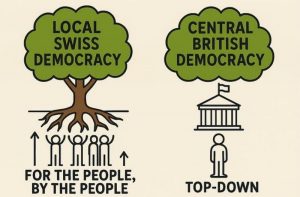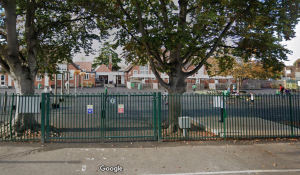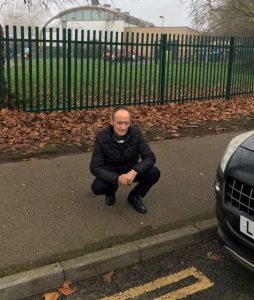Cllr Steven McCormick (RA Woodcote Ward) Chair of Epsom and Ewell Borough Council’s Licensing, Planning and Policy Committee writes for the Epsom and Ewell Times to answer many of the questions being asked about the Draft Local Plan. The views are his own and do not necessarily reflect the position of the Council.
Below are FAQs and items from the Epsom Green Belt group page and other sources.
The responses below are my own view and do not reflect that of EEBC or officers.
What is the Greenbelt and why should it be protected?
The Green Belt of land encircling London has protected by law since 1938 to keep urban sprawl in check, preventing towns from merging together and promoting the recycling of derelict land.
These purposes remain as important as they ever were, but now we know that retaining these areas is also critical in slowing and reducing the impacts of climate change, reducing flooding, reducing air pollution and providing essential habitats for wildlife.
Reply
Green belt exists throughout the country and is a barrier to prevent urban sprawl in planning terms.
- Isn’t it prohibited to build on Greenbelt Land?
Other than for very limited uses, Greenbelt Land is protected by law from development. It isn’t permitted to build housing on Greenbelt Land except in ‘Exceptional Circumstances’.
Reply
It has heavy protections but very special circumstances must be shown before development can be approved. In our draft local plan we do not have enough housing supply with brownfield or urban developments and have had to consider including green belt sites.
An alternative is to build higher and denser in our brownfield/urband sites. This has a downside of likely very tall buildings and a reduction in affordable housing delivery.
Is there any Greenbelt Land that it is OK to build on?
Some land in the Greenbelt has buildings on already, or has sites where buildings used to be. This is called ‘Previously Developed Land within the Green Belt’. Without considerable remedial work, this land doesn’t support much wildlife and is suitable for development.
- Are there exceptional circumstances that require building on the Greenbelt now?
No. The Borough can continue to meet the historical trend of growth in housing need (225 homes / year) through development of Brownfield sites only.
Every year Epsom & Ewell Borough Council, as with all other Councils nationwide, have a housebuilding target. As with many other Councils, the target has not been met each year. Whilst it would be difficult (but not impossible) to meet a 576 house target each year, this is a normal situation both in Epsom & Ewell and across the country. It is not exceptional.
The Draft Local Plan states that this is exceptional to justify their plans to build on the Greenbelt.
Reply
The historical trend is not what local plans are driven to achieve by central government. The start point is based on the standard method, which our draft local plan achieves 52% of that need.
Yes there is a consultation on various aspects of the NPPF but at this point in time our target remains based on the 2014 ONS data. As is shown by the recent response from the planning inspector to MVDC it is not current policy, it is consultation and we have to progress on what we have in front of us and that which is currently law.
Furthermore each year a council doesn’t meet its housing delivery target they have to justify to central government the reasons for this and the plans to address this. The council runs a risk of being designated which means we loose our local planning control and a central government inspector takes over.
Exceptional circumstances are shown via an evidence based approach to a draft local plan. This is what we have done. The end goal is to get a new local plan adopted and to do that it has to stand up to scrutiny and challenge.
- Were Clarendon Park, Livingstone Park, and Manor Park built in the Greenbelt, and if so, what’s different about these proposals?
All these estates were built on the sites of the old cluster of hospitals. These were Previously Developed sites within the Greenbelt, therefore developing these sites did not have a detrimental impact on environment and wildlife.
Reply
These were sites in the green belt. They had to prove the previously developed land situation to show very special circumstances existed to develop in the green belt.
Further evidence was provided to support the development in the green belt of these sites.
- There’s an area of Greenbelt on the Local Plan map that isn’t on the Priority Development list of 9 sites, does this mean it is safe from development?
No. All sites bordered in green on the map have been put forward for potential development. If the Council includes any Greenbelt sites on the Priority list, all other Greenbelt sites are at risk of future development.
Any site may be included in a future iteration of the current Local Plan, could be included by the Planning Inspector in the course of their review of the current Local Plan, or could be included in future Local Plans.
Reply
As part of the process a call for sites was made which is a requirement of the local plan process. All sites put forward by landowners and developers have to be evaluated for viability and whether they can deliver housing.
Some sites are more deliverable than others.
Some sites are not viable I.e the development costs would be too much.
Some sites proposals may be amended to make them viable or deliverable.
The next stage of consultation, regulation 19, March 2024 will see a more detailed draft local plan put forward for a further six week public consultation.
Additional sites may come forward between now and then.
- Does the Draft Local Plan meet the need to supply affordable housing for lower paid workers and the homeless?
No. Although the plan discusses building 40% ‘affordable housing’ on Greenbelt land and 30% on Brownfield land, this housing may not actually be affordable to those in need.
The definition of ‘Affordable Housing’ in the National Planning Policy Framework is houses sold at a 20% discount to their market value. In Epsom, the average property sold over the last 12 months was £630k, to an average property sold as ‘Affordable Housing’ would cost about £510k. This is well out of reach of most people in need of housing in the Borough.
Reply
The Housing and Economic Delivery Needs Assessment (HEDNA) describes the requirement for affordable units across the plan period. The number is circa 670 per year. To start describing cost of housing in the way above is misleading. There are other options, First Home scheme, social rent scheme, shared ownership schemes to help residents get a home.
Over the last 2 years the borough provided 12 affordable units.
The borough spent approximately £1.5m on overnight homeless accommodation for our residents. This is not sustainable.
This needs to change.
The draft local plan is seeking to deliver 30% affordable from brownfield and 40% from green field developments.
- Is it permissible to submit a Local Plan which doesn’t meet the full housing need calculated under the government’s ‘Standard Method’, and can it be approved?
Yes. Many other boroughs have done so or are planning to do so such as Mole Valley, Elmbridge, with Worthing Council recently got its Local Plan approved by Inspector with only meeting 25% of its target.
Reply
MVDC have had a response from the planning inspector to make progress.
Submitting a plan with numbers significantly below the target will likely yield the plan being found unsound, thrown out, forced to re-do or the planning inspector does it for us.
Epsom has a number of 5400 of 10,368, 52% of the target.
- I’ve been told that Mole Valley had their request to remove Greenbelt from their Local Plan rejected by the Planning Inspector, is this true, and if so how does it affect the Epsom & Ewell Local Plan?
Mole Valley is in the difficult position of having originally submitted a Local Plan to the planning Inspector which included developing Greenbelt. A number of Councillors were voted out of office as a result and the new Councillors are trying retrospectively to amend the submission. There appear to be significant hurdles to doing this.
Despite that, the Inspector has offered to pause the examination to give time for new Government legislation to be issued (see FAQ 10, below) which may support their case for a change to the submitted plan. It looks like Mole Valley has been offered a lifeline for their challenge.
The implications for Epsom & Ewell are:
a. It is better to exclude Greenbelt from the initial Local Plan submission to the Planning Inspector that to try to change the submission later.
b.The Planning Inspector recognises the likelihood that changes to the National PlanningPolicy Framework will strengthen the case for excluding Greenbelt from development.
There is no reason to push ahead with a flawed plan that destroys precious Greenbelt.
Reply –
The planning inspector responded to the request stating –
She wishes to make it clear that there has not been a change in Government policy. Rather, the Government is currently consulting on a draft NPPF. Until Government policy is changed (expected in Spring 2023), the Inspector will continue to examine the submitted Plan against current Government policy, contained in the NPPF 2021. She therefore cannot recommend MMs predicated on draft Government policy that may or may not come into effect in its draft form.
The full document can be found here – https://futuremolevalley.org/wp-content/uploads/2023/02/ED57-Inspectors-Note-23-Reply-to-Councils-Note-31-on-Removing-Green-Belt-Sites-from-the-Local-Plan.pdf
- I heard that the Government is going to abolish the mandatory housing target and no longer require Local Authorities to review Green Belt for housing. Is this true?
Yes, The National Planning Policy Framework specifically states that, with suitable justifications (such as protecting Greenbelt), the full housing target need not be met.
The government intends to implement many of its proposed policy changes by May 2023.
Policy changes include a change to emphasise that the standard method for calculating housing need is “advisory”, removal of the requirement for councils to continually demonstrate a five-year housing land supply, and new lines that stress councils are not required to revise Green Belt boundaries or build at densities out of character even if they are set to miss their house building targets.
Emerging policies do carry substantial weight in planning decisions, therefore at least 20 Councils have already withdrew or paused their Local Plan process, citing the upcoming policy changes. Therefore it is entirely up to EEBC if they would want to be against Central Government policy and continue pushing for large housing development on Green Belt.
Reply
The government has said they are going to consult on possibly changing the housing number calculations. Until they do and change the law and related policies we have to proceed under the current requirements.
MVDC has had a response from their planning inspector saying exactly that.
Until the regulations, policy and law changes we have to use what is currently in place.
- The roads into Epsom are already overcrowded, particularly at peak times. What are the plans to address the additional traffic from all the new housing?
According to the 2011 census, there is an average of over 1.5 cars per household in Surrey. That equates to 2,300 new cars from proposed building on the Greenbelt Horton Farm alone.
There are no obvious ways to build new roads or expand existing ones.
No infrastructure plans have been put forward to show how this increased traffic will be managed. Expect long queues!
Reply
Infrastructure is a consideration once the high level draft local plan has been published. The council works with infrastructure delivery partners after regulation 18 to determine what new additional infrastructure may be required and needed to support the proposals.
Infrastructure Delivery Partners rarely come to the table before a draft local plan is published.
- It is difficult to get my child into primary school / secondary school as there aren’t enough places. If the proposed houses are built, will I still get a school place for my children?
Local primary and secondary schools are either full or near to capacity.
No plans have been put forward for building new schools or expanding existing ones. No land has been allocated for this either. There is no guarantee of a school place and no priority for existing residents.
Reply
Similar to the roads section above.
- I see there are plans to build new sites for Gypsies / Travellers. How many will there be and where will these be located?
Regulations require Borough Councils to provide for the Traveller community. The Council has proposed putting 10 traveller sites on the Greenbelt Horton Farm site.
No explanation has been provided for why they are proposed to be located in a single area or on a Greenbelt site.
Reply
Further detail will be provided in the next stage of the draft local plan. Comments from the consultation will be considered, the next stage of how these sites maybe implemented will be further detailed.
- Why is the housing target so high?
The short answer is that it doesn’t need to be.
Here’s some maths to show why…
The actual population growth of the Borough over the last 10 years has been 5,798, an average of 580 people/year (Source: Draft Local Plan para 1.39).
There are 2.58 people in an average household in the Borough (Source: Draft Local Plan para 1.39).
If growth continues at this rate, there would be a need for 225 new homes to be built each year.
The target included in the Draft Local Plan is for 576 new houses per year. This is based on a ‘Standard Method’ (Source: Housing and economic needs assessment – GOV.UK (www.gov.uk)) which uses a household growth projection from 2014 as a starting point.
The more up-to-date 2018 household growth projection is considerably lower than the 2014 projections, reflecting more recent real growth figures.
This is then increased by 40%, based on the current high cost of housing in the Borough, to give an even higher housebuilding target than the inflated 2014 based figure.
As a result, the quoted housing target is more than 2.5x the need based on the historic population growth in the Borough.
Reply
The housing target is set by central government via the standard method using 2014 ONS data.
Even with with the standard method number our draft local plan is currently showing a 52% delivery of housing supply. 5400 vs target of 10,368.
- There seem to be lots of sites within Epsom’s urban area that are vacant, run down or underutilised, could these be developed for housing instead of the Greenbelt?
Yes.
Some of these sites have already been earmarked by the Council for development, but many haven’t.
The National Planning Policy Framework (which contains mandatory guidance for preparing the Local Plan) para 141 states that before concluding ‘exceptional circumstances’ exist for developing on Greenbelt, the strategy must:
a) make as much use as possible of suitable brownfield sites and underutilised land; and
b) optimise the density of development… including… a significant uplift in minimum density standards in town and city centres and other locations well served by public transport.’
There are lots of sites across Epsom town / urban areas which are not being put forward for use in the Local Plan or appear to be underutilised (for instance the Council’s proposals for the town hall site don’t meet the minimum density requirements they set in policy S3).
Reply
The Epsom Town Masterplan is due to complete at the end of March and will input into the next stage of the draft local plan. The site area will be reviewed, optimised with options coming forward to members for a steer/view.
- Does the Borough have to build houses on Greenbelt Land to meet the housing target?
No. In fact it is only permitted to build on Greenbelt in ‘Exceptional Circumstances’.
The National Planning Policy Framework specifically states that housing targets need not be met if it would require building on the Greenbelt (para 11 note 7).
Reply
Similar to an item above. If we are unable to deliver all our housing from brownfield or urban sites we have to consider green belt. Some green belt sites have been put forward during the call for sites which have been evaluated. A small number of these are considered viable at this point and could deliver housing.
- The Ashley Centre Local Plan display states that development will be ‘Located away from areas of flood risk’. How has Horton Farm been selected for development as it regularly gets flooded?
‘Horton’ roughly translates from Old English to ‘muddy farm’. Both the Environment Agency flood maps and Epsom & Ewell Borough Council’s own 2018 Flood Risk Assessment show that Horton Farm is at high risk of flooding from surface water (because there is clay just below the surface) and in practice it is often flooded. A ‘Critical Drainage Area’ runs through the site.
The Draft Local Plan appears to ignore the flood risk assessment and only considers flooding from rivers.
If the Greenbelt Horton Farm is built on, there is a significant risk that it will result in increased flooding into West Ewell and Ewell Court.
Source: Epsom & Ewell Borough Council Strategic Flood Risk Assessment 2018, Figure 108. Brown areas are in the highest category of flood risk.
Reply
The Ashley Centre Local Plan, read the display boards showing key items of the draft local plan in the Ashley Centre.
Any site being put forward would still need to submit a full and thorough planning application which may include flood risk evaluation and mitigation.
The draft local plan does not get into that level of detail so the statement that it ignores the flood risk assessment is misleading at best.
- I’m told the Council has spent £1m on preparing this plan. Would it be expensive to change direction now?
The money that has been spent is largely on reports that were required to be prepared whatever direction the plan went in.
The earlier changes are made to protect the Greenbelt, the cheaper it is to make those changes.
Reply
All funds spent on the local plan have been shown in LPPC and S&R committees.
Yes there are consultants involved to prepare reports and evidence as we don’t have that skillset; this is not unusual and many other boroughs adopt the same approach.
It has to be understood that there is a large body of evidence behind the local plan. Adding or removing sites from the spatial strategy itself has a knock on of recreating that evidence.
The decision point on changes to the spatial strategy and which sites are in or out has no relevance on cost. The work still needs to done, the evidence still needs to be created.
If the plan is paused then the evidence base may need to be re-worked depending on the length of pause.
- How will developing the Greenbelt land affect wildlife?
The Greenbelt land is a vital habitat, providing food and shelter for hundreds of species of mammals, birds, amphibians and insects as well as native trees and flowers.
As an example, Horton Farm supports roe deer, bats, greater spotted and green woodpeckers, sparrowhawks, house sparrows, stag beetles, song thrushes, hedgehogs, common toads, and other priority species.
Reply
Any planning application coming forward would have to consider the environmental impact. The updated policies coming forward in our draft local plan are up to date and current on once adopted would help structure applications coming forward.
What follow are questions I was asked at the Bourne Hall and Ashley Centre drop in sessions.
Q: Why aren’t residents at and around the proposed sites being communicated with? In the same way as when a planning application is lodged, impacted households get informed.
A: The planning application approach typically has limited effectiveness and a broad communications approach to all borough residents was selected.
Q: Residents only just heard about this because of the Ashley Centre display boards.
A: This was the goal of the boards in the Ashley Centre factored with social media, Borough Insight, Libraries and other outlets.
Q: Is this the only chance we have to input?
A: It is stage 2 of a 7-stage process. This is the first consultation piece.
Q: Infrastructure. Where is it in the plan(s)?
A: At this stage infrastructure delivery partners rarely come to the discussion table at such an early stage. This is part of the motivation to get our draft local plan published to kick start those discussions. There are sections in the draft local plan document on infrastructure but they are high-level at this stage.
Q: Why are we putting the green belt forward?
A: Based on the brownfield and urban sites that have come forward via the call for sites we are very short of our housing number target/start point of 10,000+ We either intensity our brownfield and urban sites by building higher or we consider green belt sites that have come forward.
Q: Why are only 90 homes in the Town Hall allocation?
A: The Epsom Town Masterplan is due to complete in March and will inform the draft local plan into Regulation 19. It is expected this number would increase significantly especially given the steer from council to move to 70 East Street.
Q: Where does it stop? After this local plan do we get asked for more housing by the government?
A: A very good question, at this point based on what we know, come 2040 we may be challenged again to deliver more housing.
Q: Mole Valley has paused and removed all its green belt. Why can’t we do the same?
A: In theory we can however Mole Valley are at a very different stage. Pausing at this point would be to wait and see what the outcome of the consultation, mainly on housing numbers. Our draft local plan currently proposes to deliver 52% of the housing number. Any update on housing numbers would only beneficial to us if that number came down significantly In the meantime we need to progress.
The planning inspector has just replied and told MVDC that they can’t remove green belt via the major modiciations method and that a pause is possible but they should consider not protracting the examination.
Q: As these sites are in the draft local plan is that it?
A: No, the process flows through to Stage 7 and even then a planning application is still required.







